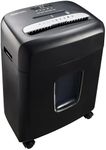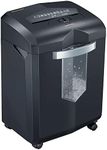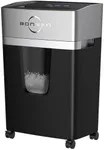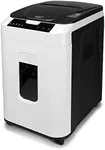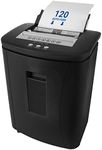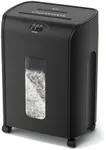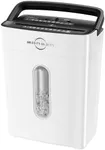Buying Guide for the Best Micro Shredders
When it comes to choosing a micro-shredder, it's important to consider several key specifications to ensure you get the best fit for your needs. Micro-shredders are designed to provide high security by cutting paper into tiny pieces, making it nearly impossible to reassemble and read. To make an informed decision, you should understand the various features and how they align with your specific requirements. Here are the key specs to consider and how to navigate them.Security LevelThe security level of a shredder is determined by the size of the shredded particles. Micro-shredders typically offer higher security levels, such as P-4, P-5, P-6, and P-7. The higher the number, the smaller the particles and the more secure the shredding. For general office use, a P-4 or P-5 level is usually sufficient, while P-6 and P-7 are suitable for highly confidential documents. Consider the sensitivity of the documents you need to shred to choose the appropriate security level.
Sheet CapacitySheet capacity refers to the number of sheets a shredder can handle at once. This is important for efficiency, especially if you have a large volume of documents to shred. Micro-shredders typically have a lower sheet capacity compared to strip-cut or cross-cut shredders. Capacities can range from 5 to 20 sheets. If you need to shred large amounts of paper frequently, opt for a higher sheet capacity. For occasional use, a lower capacity may suffice.
Run Time and Cool Down TimeRun time is the duration a shredder can operate continuously before needing to cool down, while cool down time is the period it needs to rest before it can be used again. These times vary widely among models. For light, occasional use, a shredder with a short run time and longer cool down time may be adequate. However, for heavy use, look for a shredder with a longer run time and shorter cool down time to avoid frequent interruptions.
Bin CapacityBin capacity indicates how much shredded material the shredder can hold before it needs to be emptied. This is measured in gallons or liters. A larger bin capacity means less frequent emptying, which is convenient for high-volume shredding tasks. For personal or small office use, a smaller bin may be sufficient. For larger offices or heavy use, a bigger bin will be more practical.
Noise LevelNoise level is an important consideration, especially in a shared or quiet workspace. Shredders can vary significantly in how loud they are during operation. Noise levels are usually measured in decibels (dB). If you need a quieter shredder, look for models specifically designed to operate at lower noise levels, typically around 60-70 dB. For home use or environments where noise is less of a concern, this may be less critical.
Additional FeaturesAdditional features can enhance the usability and safety of a shredder. These may include jam-proof technology, auto-feed capabilities, safety sensors, and energy-saving modes. Consider which features are important to you based on your specific needs. For example, if you frequently deal with paper jams, a shredder with jam-proof technology can save you time and frustration. If you want to reduce energy consumption, look for models with energy-saving features.


